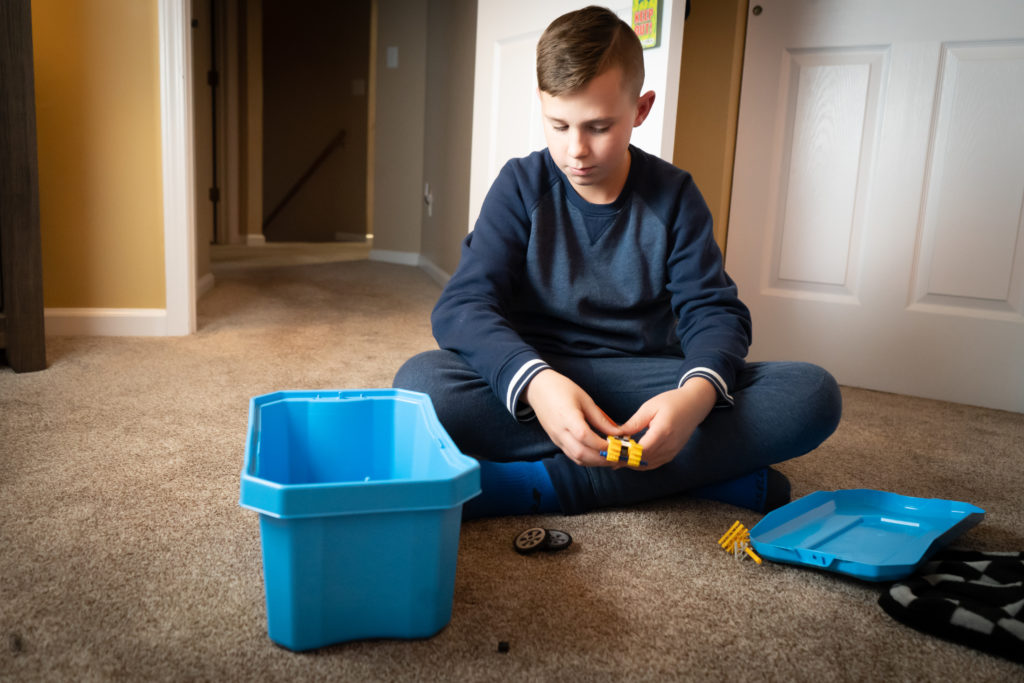
Aprison warden and a corrections officer; the pairing evokes images of imposing fences, starched collars and harsh rules. Yet the house I found myself parked in front of was normal – a normal house, a normal neighborhood. On the drive to meet the Conways, the sounds of blaring alarms had been the naïve backdrop I had conjured up for their lives.
The setting I found myself in, however, was filled with the sounds of children streaming home from their bus stops, making quick plans to fill the few hours of light left in the day. As my coworker and I pulled the gear from our respective cars, the preconceived notions that had been bumping around in my mind faded; I knew better. I’d met enough foster parents to know you shouldn’t judge a book by its cover, so I hauled our gear up the driveway to meet Craig, Ed and Aiden, but tried to leave my childish imaginings in the car.
Craig answered the door, a looming man with a close-cropped haircut and intense blue eyes, and in the moment before he spoke, I felt like I really was meeting a warden.
But then he spoke.
His warm and effortless greeting shattered that perception.
“Hey, come in, come in!” As my coworker and I entered, a young, bright-eyed ten-year-old boy popped out from behind Craig. “This is Aiden.”
“Hello!” he said in that enthusiastic yet entirely uninterested manner that children can have when talking to someone new. It wasn’t long before he was filling me in on his favorite Naruto character (it’s Neji) and going on at length about his frustration with noobs in Fortnite. He sounded pretty much exactly like my own son.
“Ed’s upstairs right now, but you can get set up wherever you like, down here, up there,” Craig said as he showed us around. He was really talking to my coworker at this point – Aiden and I were still chatting about his shows and games as I unpacked our equipment.
“Aiden, you can play video games for a little bit while they get set up,” Craig told Aiden before turning back to us. “Usually his video game time is scheduled, so this is a real treat for him.”
Needless to say, my conversation was cut short as Aiden quickly moved into the den on the first floor.
We headed up the neatly decorated stairwell to meet Ed.
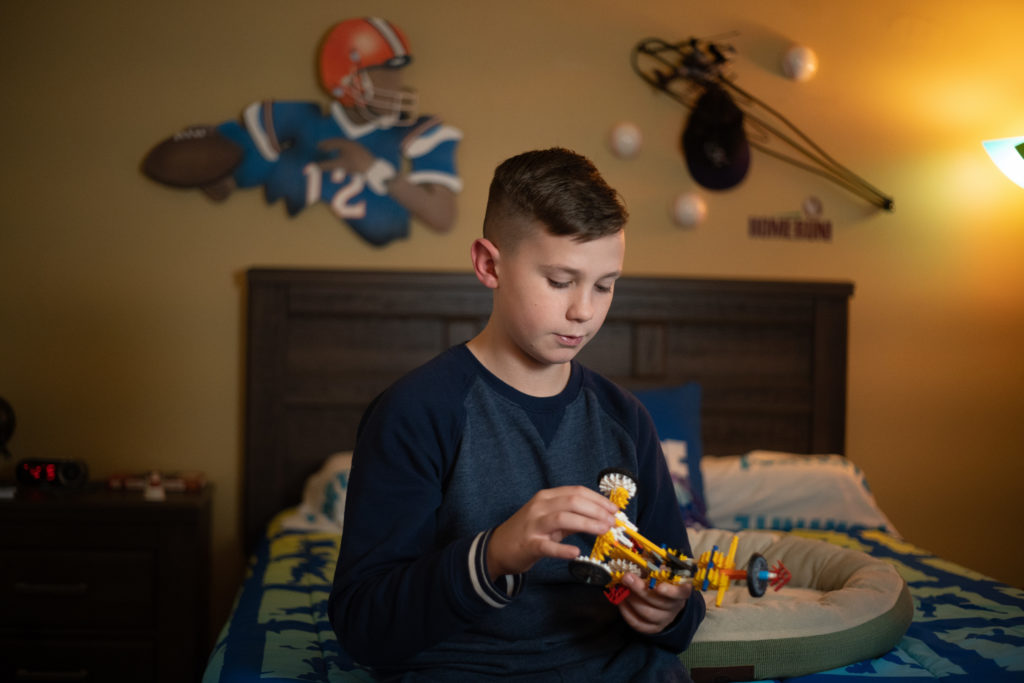
In 2004, Craig Conway and Ed Childs had filed for their Domestic Partnership and moved to Bayville, New Jersey.
“We actually met in Atlantic City, at a conference, a corrections conference.” Ed said. At the time, Craig was working for the Department of Corrections while Ed worked as a parole officer, and their respective careers had been the catalyst for their relationship.
As the country became more progressive, they began collecting anniversaries.
“So, we actually have three anniversaries,” Craig informed us. “Our Domestic Partnership, our Civil Union, and our wedding day.”
“So, we actually have three anniversaries. Our Domestic Partnership, our Civil Union, and our wedding day.”Craig Conway
But as two gay men in a town that runs more socially conservative on average for the state, there was some tension.
“An interracial, same-sex couple in Bayville,” Craig said. “While we never experienced any outright name-calling or whatever, you can sense the uncomfortable nature of things.”
But the pair were as open-minded as they were undeterred.
They understood what it was like to be misjudged.
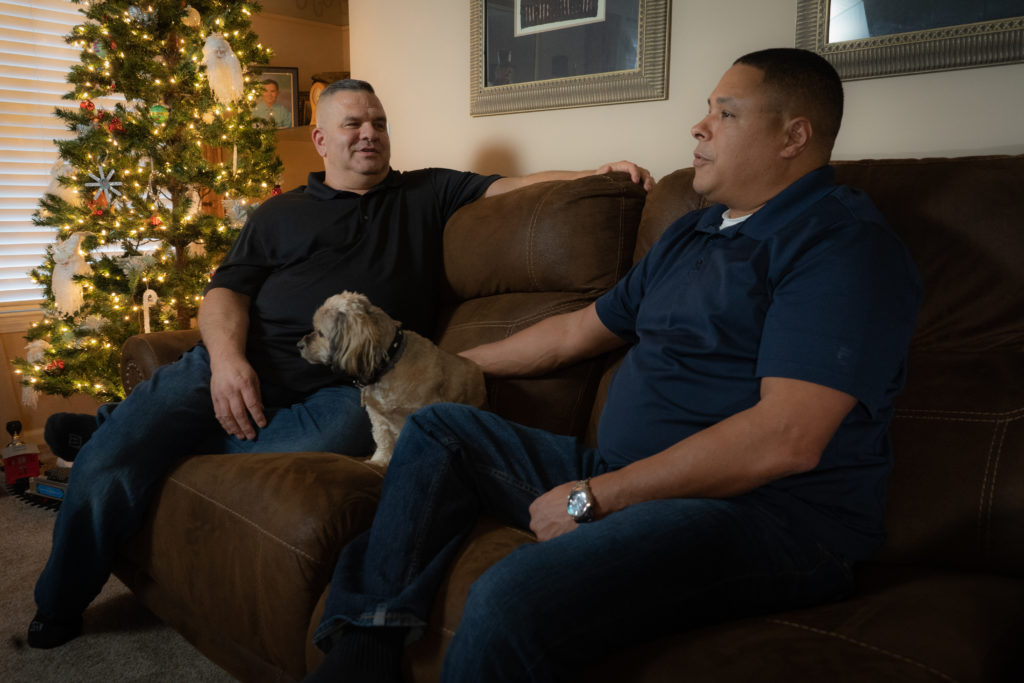
“I came home and told him the story about this kid, and he said, ‘Are you crazy?! I just started my Masters program, and what are we gonna blah blah blah blah blah.’”
Craig was talking about the day he told Ed they needed to adopt Aiden. Apparently, Ed’s chorus of concerns was not unfamiliar to his husband – just as the adoption conversation was familiar to Ed.
But the conversation was happening a little differently this time.
Craig had met Aiden at a resource home, long after his career as a warden, in his capacity as a therapeutic counselor. He came to learn that Aiden’s mother had terminated her parental rights, and Aiden was being put up for adoption. Craig, who’d been getting to know Aiden more and more every week, knew he needed to convince Ed to adopt.
That conversation didn’t start out so well.
“Yeah, I was afraid.” Ed was nodding soberly. “In my head, he was gonna be this angry child.”
And as Ed had told Craig that day, he’d just left his job to be a full-time student; could they handle all of that together?
“No… I knew we were going to adopt him,” Craig said, grinning wide. “I didn’t know just how hard I’d have to twist or what I’d have to sell out, but at that point I just knew that it was right.”
This might not have been the first time Craig had floated the idea of an adoption to Ed, but something had changed.
Ed would eventually come back out, in tears, not long after storming away. Yes, he had reservations. But as Craig told him about Aiden, Ed heard it differently than all the other times Craig had mentioned adoption. Ed had always wanted to be a parent, but as a gay man, he’d given up on the idea. However, more than a decade later, the world was a more open-minded place.
He was ready.
With Ed on board, Craig began the process. After some phone calls to caseworkers to help him figure out the next steps, the paperwork was filed. But as things progressed and they began to attend the required foster parent trainings, Ed’s reservations would resurface.
“I sat in these trainings, you know, for the parents, and a lot of the parents had the same concerns. I had one parent I was talking to, saying, ‘This kid’s gonna set my house on fire!’”

The first time I’d heard a parent express concerns over their child burning anything down, I was about Aiden’s age – 10.
My parents were driving the family home from a restaurant when they asked, “Did you turn off your Creepy Crawlers?” For the uninitiated, the Creepy Crawlers oven was basically a gross version of the Easy Bake Oven, where instead of making food you made fake bug and lizard toys – and it could get hot.
“Um, I don’t remember…” I responded sheepishly. They responded in a quiet tone that then I recognized as stern anger and disappointment, but now, as a parent, hear as mischievous. They were probably suppressing laughs.
“I hope you didn’t burn down the house…,” they said. I was immediately filled with shame and guilt – did I just destroy our home?
Years later I would learn that they had always unplugged it whenever we left. Years after that, with kids of my own, I would find myself moving around the house turning off lava lamps, unplugging Easy Bake Ovens, and blocking outlets.
Still, sometimes I forget to turn off the coffee pot – and I’m glad I don’t have a room of people taking trainings on how to live with me.
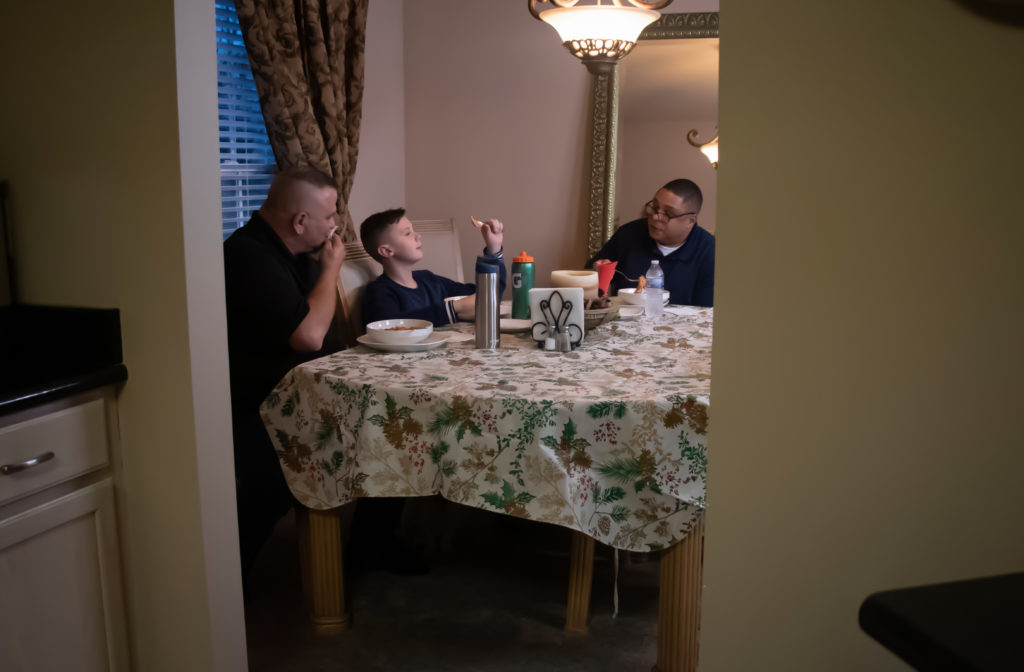
“Prior to him coming to us, and when he was in the resource home, the resource parents used to ask me for tips on dealing with him because he would do things like punch his teacher in the face. He was very very aggressive, had lots of tantrums and stuff like that.” Like any parent, Craig didn’t pass up the opportunity to praise Aiden, but he was honest about how things were at the beginning.
The truth is, statistically, kids in care are more likely to exhibit behavior issues. Unfortunately, those statistics are the same ones that sometimes create fear in prospective foster parents. This more tentative, unsure perspective, wrapped up in misconceptions, is precisely the view Ed had been operating from.
But, Craig, who’d known Aiden in his professional capacity as a counselor, was unfazed. How does a former prison warden handle behavior issues, I wondered.
“We started with a behavior chart from the beginning,” Craig told us. Right – Craig is a former prison warden. “Now he has one that has his chores, and he gets, we call it chore pay rather than allowance. We give him that at the end of the month, it goes on the calendar every week, but it used to be every day. We track it, and if he said a bad word or something like that, he’d lose a dime here and there.”
When my own kids become a handful, I basically shut down – “Just make it to bedtime,” I tell myself over and over as I hover behind my eight-year-old, who hasn’t fully grasped the idea that his sister, at 19 months, isn’t a plaything he can just pick up and start roughhousing with. And sometimes, when it IS bedtime and our oldest is just realizing it, and he breaks out into full-blown sobs? Yeah, somehow behavior charts and chore pay aren’t the first thing that come to mind. I imagined Ed developing a behavior chart in one of his trainings – how many dimes should a child lose for burning down the house?
“Just ridiculousness,” Ed said of the many fears he shared with the other parents. “None of that stuff came true.” And from everything I could see of Aiden, and everything anyone told me about him, it was actually harder to believe he’d ever been that way. Of course, it wasn’t just behavior charts.
IEPs, Individualized Education Plans, are developed by the state, parents, counselors and other members of the child’s Family Team, and are meant to consider and provide the best educational options for a child in care. Aiden had been adopted from Waretown, where the aggression and fighting had occurred – but when Craig and Ed began fostering, they enrolled Aiden in the Clara B. Worth School, where he joined a small special education class in the summer with younger, nonverbal kids. The choice of classroom was part of Aiden’s IEP.
Arlene Comstock had met Aiden’s parents during a mid-year IEP meeting, and I caught up with her over the phone to get some more insight into their family. The voice on the other end of the line was peppy and positive, absolutely thrilled to be able to tell me everything about Aiden. If she hadn’t told me she’d been working as a Special Education teacher for 17 years, the youthful enthusiasm in her voice would’ve led me to believe she was only a few years into her career.
She had known about Aiden when he came to the Clara B. Worth School, though he’d been placed with her co-worker, Mrs. Parker. The administration felt Aiden needed to stay in the smaller class even though he was with younger kids, but Arlene believed differently: “I told them, ‘What Aiden needs is love.’”
The small classroom had been good for him – Aiden seemed to flourish as a leader among the younger children, constantly cheering them on with sympathetic words like “I get it, I used to not be able to talk!” But Arlene, or Ms. Comstock, as Aiden would come to know her, still felt like he was capable of even more.
In that mid-year meeting with the duo, Arlene could tell that Craig and Ed were not quite on board with the idea of moving Aiden into the Comstock classroom. “You could tell they were apprehensive about bigger kids, kids that could be mean to Aiden.” But Arlene had a gut feeling about Aiden, and Craig and Ed trusted her.
When Aiden started class with Arlene, he didn’t know the difference between letters and numbers. “My brain thinks backwards. My brain doesn’t work that way,” was a familiar refrain from the frustrated boy. Disorganized and struggling, his frustrations would bubble up.
However, just as Arlene knew he would, Aiden quickly became a role model in the classroom.
“That kid, he’s got it all.” Arlene stated with admiration. She was nearly as impressed with Craig and Ed. To Arlene, they were real teammates, always communicating with her and with the school to make sure they had a handle on Aiden’s wellbeing.
Even better, they did something that I know I struggle to do whenever it comes up: they took advice about their kid from someone else. “Everything I said to do, they just did it. And he just changed in front of my eyes.”
Of course, not everything was perfect.
“They had bad days, you know? He would throw his homework across the room or something – but the follow-through was always there with Craig and Ed.” She gives Craig and Ed a lot of credit for the positive changes in Aiden’s life, but she was quick to make sure that Aiden was recognized for all his work. “He wanted better, he wanted to DO better. He had that drive. And Craig and Ed recognized that. They were standing behind him the whole time.”
Before we hang up, Arlene tells me that whenever she sees Craig and Ed, she gives them great big bear hugs. That image, this family of three, all coming together in a giant bear hug huddle with a local teacher, sticks in my mind, held up in stark contrast to a different, earlier image:
Ed, sitting in a row of foster parents, imagining his house burning down.
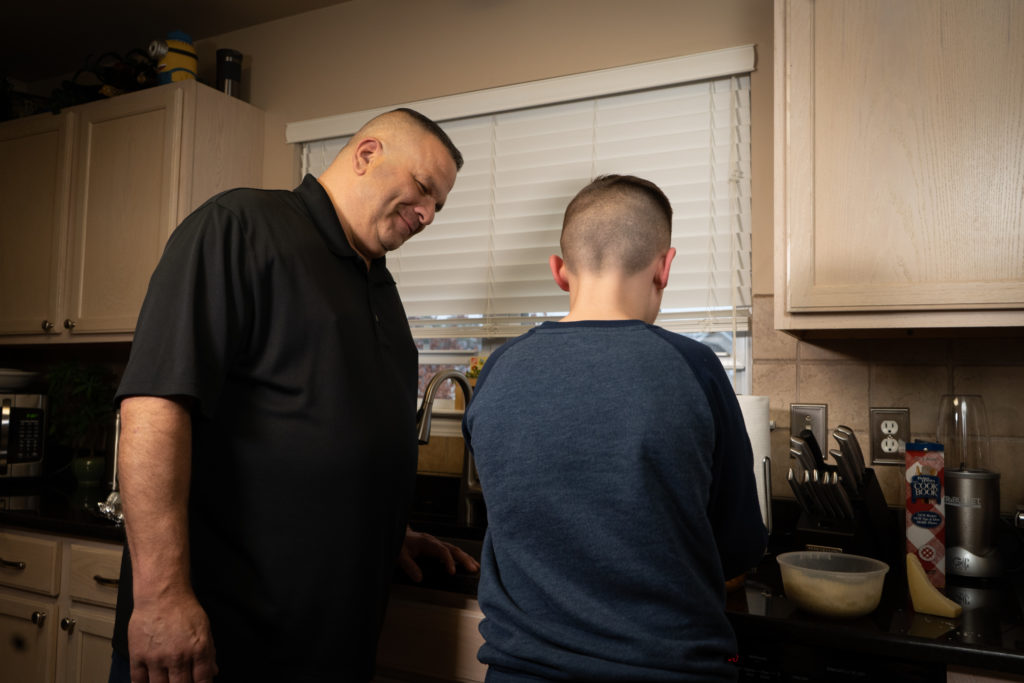
“So, I’m very big on social media, Facebook and arguing with people and stuff like that, and there was a local page that I got into arguments with people on,” Craig told us. “And they said, ‘Why don’t you go start your own page?’ So, I did.”
Craig started sharing his fostering journey on his Facebook.
“Couldn’t share names, couldn’t share pictures, but I shared that it was happening, and also started sharing stuff about fostering, adopting.” As time went on, more people from Bayville began to interact on Craig’s page. “The local bagel store – the first time we went in there, they gave Aiden $10 to put in a bank because a couple of them had been adopted.”
The ice cream place, the donut place, the sub shop, the pizza place, the little market with the woman who made empanadas for Aiden – the community was embracing their family. “Every part of this community has really been very supportive,” Craig said.
Fast forward: It’s Aiden’s adoption day, and the interracial same-sex couple is taking their newly-adopted foster son on a trip around town.
Giuseppe Gramaglia, chef and owner of Senza Cucina, met Craig and Ed a few years before they adopted Aiden. In his charming Italian accent, Giuseppe told me he appreciates the way Craig will hunt him down for a friendly hello or handshake, even going into the kitchen to find him. “Good guy. Good people, these are good people.” He knew the couple had been talking about adopting, but on that Sunday, it became a reality – and Giuseppe became an “uncle.”
“It’s like they were meant for one another. It’s the only way I can explain in simple words.”Giuseppe
“He calls me Uncle Joe, makes me feel real good. He’s a real good kid,” Giuseppe added, mentioning that he sees their family almost every week for family dinner. “From a little boy, he’s grown to a young man. Every week he seems to grow an inch!”
It’s adoption day, and Craig and Ed are about to take their son Aiden on a trip around town. As Craig peers into the kitchen looking for a handshake, Uncle Joe welcomes the family with open arms.
It’s 2019 – not 2004 – and not only is this family celebrating on the streets of Bayville, but Bayville is celebrating with them.
“It’s like they were meant for one another,” Giuseppe told me. “It’s the only way I can explain in simple words.
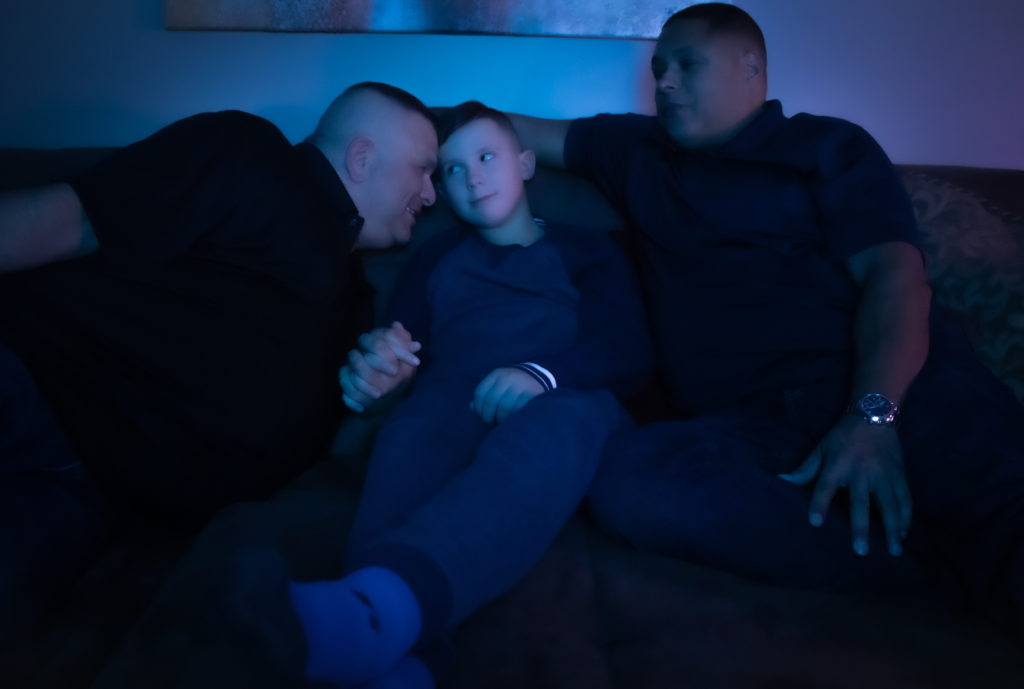
A number of years ago, on a scorching hot summer day, I was at my cousin’s house with friends. In those days, I was still smoking, and often, and the 102 degree heat did not deter me. I stepped out on to patio to smoke, and the next five minutes or so passed about as you would expect. When I was done, I tossed my cigarette in the ashtray, which was on a cooler sitting against the house.
Once I was back inside, pouring myself a glass of water, it didn’t take long for myself and my friends to recognize the smell of burning plastic. We looked around, sniffed microwaves, ovens, game consoles – until I decided to peak my head out the sliding glass door, where I noticed a literal wall of flame.
The house was on fire.
After a Benny Hill-style procession that followed after the shouts of “FIRE!” excited my friends to action, we dashed to put out the flames and call 911. The ashtray had been full of dried out, half-smoked cigarettes, which caught fire when I added my own to the pile. Being so close to the house, the heat of the flames caused the siding to go up, which is how I came to find myself panting, holding half a pot of water talking to a fireman. The fire was out before the firefighters arrived, and the damage was thankfully limited.
I don’t think my parents ever really expected me to become an adult who would actually set fire to something. And I know I never wanted to burn down my cousin’s house. Still, it is now an indisputable part of who I am. Unlike Aiden, or other kids in foster care, however, no one’s got this story written in a file. I don’t have to share my mistakes – smoking cigarettes, being careless – if I don’t want to. That freedom is a privilege I have – the privilege to present myself to the world and be received on my own terms, with respect.
And as I packed up all my gear and said my goodbyes to their family, I realized that this was the balance Craig, Ed and Aiden had found here in Bayville, New Jersey. When I see them together, there is no hint of so many of the labels that came up in our discussions.
They’re not a same-sex, interracial couple and an adopted son – they’re a family.

“Yeah, that was me,” Ed said, begrudgingly admitting that he had been the parent on duty at the water park during what I’ll call, “the incident.” To Ed’s terror, he suddenly heard Aiden screaming, on his back. A puddle, the perennial parenting foe, had made Aiden slip and slam his head, causing a single tooth to be ejected from his mouth – Ed went into panic mode.
As he was telling me all of the thoughts and anxieties that raced through his mind as he rushed Aiden to the hospital, calling Craig along the way, I couldn’t help but notice the deep softness in Ed’s voice. He was soft-spoken and reserved compared to Craig’s more boisterous and self-assured personality. Where Craig at first appeared exactly how I might imagine a prison warden – imposing and intense, Ed seemed more like an engineer. The polo, the slender glasses and quieter demeanor had me questioning – a corrections officer? And just as with Craig, there was no hint of that steely, prison-hardened persona I had idly imagined before meeting them.
Ed continued.
“That was the most terrifying thing I had ever seen. I freaked,” he admitted. “I had worked in corrections, I had been in a hundred scenarios where it was a crisis situation.” Still, the incident really got to him. “It was just frightening. That was a moment I felt like a BAD dad,” he now laughed. Even still, it was clearly a “thing” for him – the kind of thing that children have a unique way of creating. A thing, sitting in the pit of your stomach, that leaves you breathlessly anxious and yet somehow also incredibly grateful.
Your child was hurt! How could this have happened?!
-and then-
You’ve made it better. Your child will be okay.
Somehow, both feelings exist inside of you at the same time, a nagging self-doubt right alongside a confidence that you can take care of your child, that you, IN PARTICULAR, can take care of your child. This was what I sensed beneath Ed’s begrudging admission; a self-critical voice pushed down by the knowledge that everything had turned out alright. I understand that feeling when your child gets hurt and you’re the one filling in your spouse over the phone.
You don’t want to feel like a bad parent.
You don’t want to be misjudged.
“These things happen,” Ed said, waving off his own doubts.
I can relate. We’re parents.
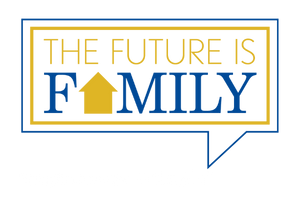

We met Craig & Eddy some years ago (we also live in Bayville), prior to Aiden joining the family. Couldn’t have been more happier for them when they got to adopt him and complete their perfect family 🤗.
When you see the three of them together with those huge smiles it’s absolutely breathtaking. I can’t imagine them without Aiden who is a young gentleman. You two are doing an outstanding job raising Aiden.
Wishing you continued happiness and blessings forever 👍🤗🙏🏻👏.
You’re story is absolutely beautiful and hope more people read it and take the chance to adopt you make the world a better place👍
Thank you Linda!
We think so too! They’re an amazing family!